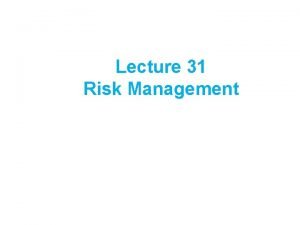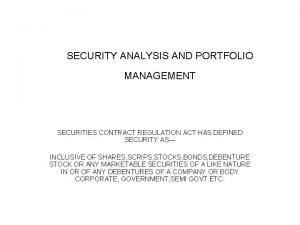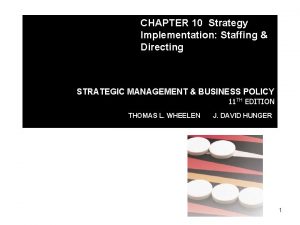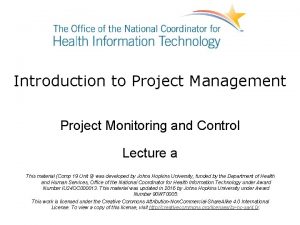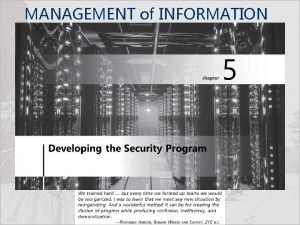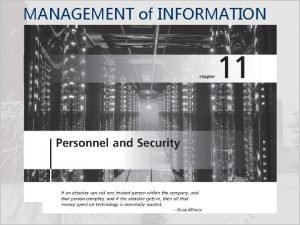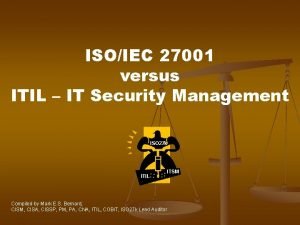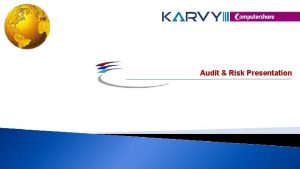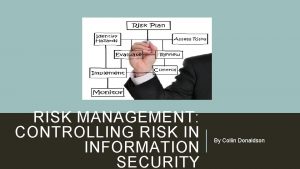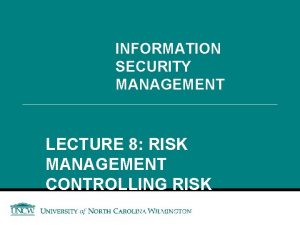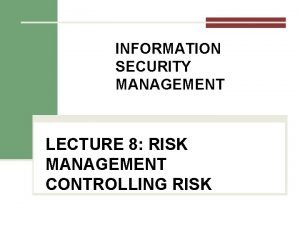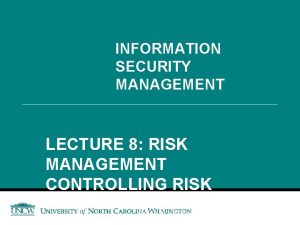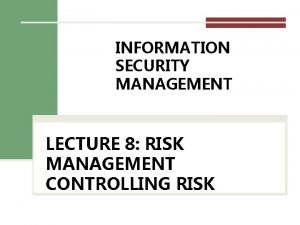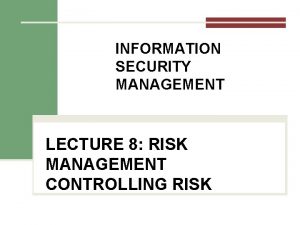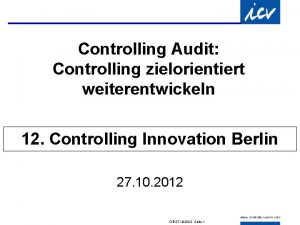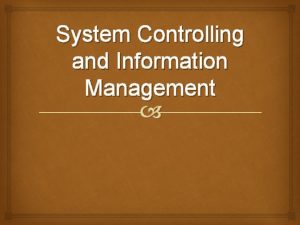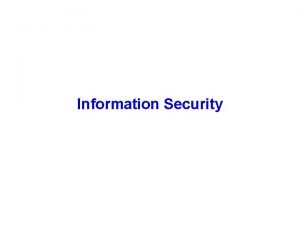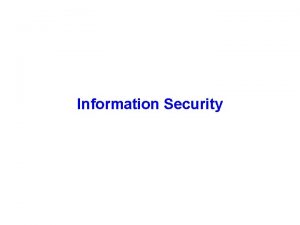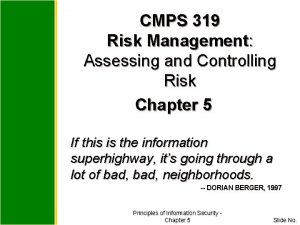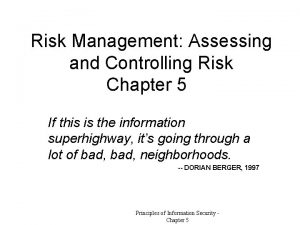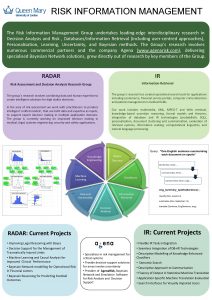INFORMATION SECURITY MANAGEMENT LECTURE 8 RISK MANAGEMENT CONTROLLING


























- Slides: 26

INFORMATION SECURITY MANAGEMENT LECTURE 8: RISK MANAGEMENT CONTROLLING RISK You got to be careful if you don’t know where you’re going, because you might not get there. – Yogi Berra

Managing Risk (cont’d. ) Figure 9 -1 Residual risk Source: Course Technology/Cengage Learning

Managing Risk – Risk Control • Risk control involves selecting one of the four risk control strategies Should the organization ever accept the risk?

Risk Control Cycle Figure 9 -3 Risk control cycle Source: Course Technology/Cengage Learning

Cost Benefit – Asset Valuation n Asset value: replacement cost and/or income derived through the use of an asset n Exposure Factor (EF): portion of asset's value lost through a threat (also called impact) Single Loss Expectancy (SLE) = Asset ($) x EF (%)

Cost Benefit – Asset Valuation n Annualized Rate of Occurrence (ARO) n Probability of loss in a year, % Annual Loss Expectancy (ALE) = SLE x ARO

Example of Quantitative Risk Assesment n Theft of a laptop computer, with the data encrypted n Asset value: $4, 000 Exposure factor ? SLE, ARO, ALE ?

Example of Quantitative Risk Assesment n Dropping a laptop computer and breaking the screen n Asset value: $4, 000 Exposure factor ? SLE, ARO, ALE ?

Cost-Benefit Analysis Calculation CBA = ALE(prior) – ALE(post) – ACS – ALE (prior to control) is the annualized loss expectancy of the risk before the implementation of the control – ALE (post-control) is the ALE examined after the control has been in place for a period of time – ACS is the annual cost of the safeguard

Example of Cost-Benefit Analysis Calculation n Dropping an i. Pad and breaking the screen n Asset value: $700 n Exposure factor: 50% SLE = ARO = 25% chance of damaging ALE (prior) = n ALE (post) = n n CBA (cost of case = $30) n CBA = ALE(prior) – ALE(post) – ACS n CBA =

Example of Cost-Benefit Analysis Calculation n Unprotected customer database n Asset value: $200, 000 n n n Exposure factor: 50% SLE = ARO = 75% chance of occurring ALE (prior) = ALE (post) = n CBA (ACS = $5, 000) n CBA = ALE(prior) – ALE(post) – ACS n CBA =

Recommended Risk Control Practices • Qualitative/Quantitative Approach • Octave Methods • Microsoft Risk Management Approach • FAIR

Qualitative and Hybrid Measures • Quantitative assessment • Qualitative assessment • Hybrid assessment

OCTAVE Method • The Operationally Critical Threat, Asset, and Vulnerability Evaluation (OCTAVE) Method • Variations of the OCTAVE method – The original OCTAVE method – OCTAVE-S – OCTAVE-Allegro www. cert. org/octave/

Microsoft Risk Management Approach • Four phases in the Microsoft Info. Sec risk management process: – – Assessing risk Conducting decision support Implementing controls Measuring program effectiveness www. cert. org/octave/omig. html

Microsoft Risk Management Approach Figure A-1 Security Risk Management Guide Source: Course Technology/Cengage Learning

Factor analysis of Information Risk (FAIR) • Basic FAIR analysis is comprised of four stages: • Stage 1 - Identify scenario components • Stage 2 - Evaluate loss event frequency • Stage 3 - Evaluate probable loss magnitude(PLM) • Stage 4 - Derive and articulate Risk • Unlike other risk management frameworks, FAIR relies on the qualitative assessment of many risk components using scales with value ranges, for example very high to very low http: //fairwiki. riskmanagementinsight. com

FAIR (cont’d. ) Figure 9 -4 Factor analysis of information risk (FAIR) Management of Information Security, 3 rd ed. Source: Course Technology/Cengage Learning (Based on concepts from Jack A. Jones)

HEALTH FIRST CASE STUDY Analyzing Risk

Step 1: Define Assets

Step 1: Define Assets Consider Consequential Financial Loss Asset Name $ Value Confidentiality, Integrity, and Availability Notes Direct Loss: Consequenti Replaceme al Financial Loss nt Medical DB C? I? A? Daily Operation (DO) Medical Malpractice (M) HIPAA Liability (H) Notification Law Liability (NL)

Step 1: Define Assets Consider Consequential Financial Loss Asset Name $ Value Confidentiality, Integrity, and Availability Notes Direct Loss: Consequential Replacement Financial Loss Medical DB DO+M_H+NL C IA Daily Operation (DO) $ Medical Malpractice (M) $ HIPAA Liability (H) $ Notification Law Liability (NL) $

HIPAA Criminal Penalties $ Penalty Imprisonment Offense Up to $50 K Up to one year Wrongful disclosure of individually identifiable health information Up to $100 K Up to 5 years …committed under false pretenses Up to $500 K Up to 10 years … with intent to sell, achieve personal gain, or cause malicious harm Then consider bad press, state audit, state law penalties, civil lawsuits, lost claims, …

Step 2: Estimate Potential Loss for Threats Step 3: Estimate Likelihood of Exploitation n Normal threats: Threats common to all organizations n Inherent threats: Threats particular to your specific industry n Known vulnerabilities: Previous audit reports indicate deficiencies.

Step 2: Estimate Potential Loss for Threats Step 3: Estimate Likelihood of Exploitation

Step 4: Compute Expected Loss Step 5: Treat Risk Step 4: Compute E(Loss) ALE = SLE * ARO Asset Threat Single Annuali Annual Loss zed Rate Loss of Expecta Occurre ncy nce (ALE) (SLE) (ARO) Step 5: Treat Risk n Risk Acceptance: Handle n n attack when necessary Risk Avoidance: Stop doing risky behavior Risk Mitigation: Implement control to minimize vulnerability Risk Transference: Pay someone to assume risk for you Risk Planning: Implement a set of controls
 Liquidity measures
Liquidity measures Privat security
Privat security Risk management lecture
Risk management lecture Visa international security model diagram
Visa international security model diagram Cnss security model คือ
Cnss security model คือ 01:640:244 lecture notes - lecture 15: plat, idah, farad
01:640:244 lecture notes - lecture 15: plat, idah, farad Uphcp
Uphcp Key risk indicators for vendor management
Key risk indicators for vendor management Risk map risk management
Risk map risk management Risk in security analysis and portfolio management
Risk in security analysis and portfolio management Computer security 161 cryptocurrency lecture
Computer security 161 cryptocurrency lecture Function
Function Staffing and directing
Staffing and directing Project management monitoring and controlling
Project management monitoring and controlling Chapter 9 information management and security
Chapter 9 information management and security Project management for information security
Project management for information security Management of information security 5th edition
Management of information security 5th edition Isoiec27001
Isoiec27001 Audit notification
Audit notification Risk projection attempts to rate each risk in two ways
Risk projection attempts to rate each risk in two ways Risk avoidance
Risk avoidance How to calculate relative risk
How to calculate relative risk Residual risk and secondary risk pmp
Residual risk and secondary risk pmp Inherent risk vs control risk
Inherent risk vs control risk Absolute risk vs relative risk
Absolute risk vs relative risk Activity sheet 2: stock market calculations answer key
Activity sheet 2: stock market calculations answer key Firm risk scorecard
Firm risk scorecard


